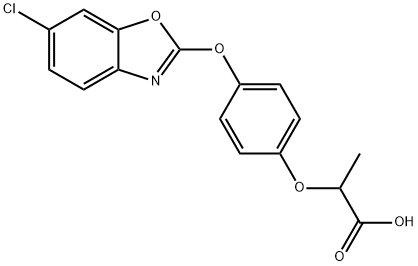FENOXAPROP-ETHYL
Synonym(s):Anti-JFY1;Anti-PUMA;BBC3;BCL2 binding component 3;Bcl-2 binding component 3
- CAS NO.:66441-23-4
- Empirical Formula: C18H16ClNO5
- Molecular Weight: 361.78
- MDL number: MFCD01574785
- EINECS: 266-362-9
- SAFETY DATA SHEET (SDS)
- Update Date: 2024-12-18 14:08:57

What is FENOXAPROP-ETHYL?
Chemical properties
Colorless or white solid. Liquid form is dark brown with an aromatic hydrocarbon odor.
The Uses of FENOXAPROP-ETHYL
Fenoxaprop-ethyl is a selective, postemergence herbicide for control of annual and perennial grass weeds in crops such as beans, beets, cotton, groundnuts, potatoes and other vegetables.
The Uses of FENOXAPROP-ETHYL
Fenoxaprop-ethyl is a pesticide.
Definition
ChEBI: Fenoxaprop ethyl is an aromatic ether.
General Description
Coarse light beige to brown powder. Selective herbicide.
Agricultural Uses
Herbicide: Used to control annual and perennial grassy weeds in potatoes, soy beans, beans, beets, vegetables, flax, ground nuts, rape and cotton. Not approved for use in EU countries. Not registered for use in the U.S. There are 17 global suppliers.
Trade name
ACCLAIM®[C]; DEPON®; EXCEL®; FENOXYPROP®; FURORE®; HOE 033171®; HOE-A 25-01®; OPTION® Fenoxaprop-ethyl; PUMA®; WHIP®
Potential Exposure
A chlorophenoxy/aryloxyphenoxypropionate herbicide used to control annual and perennial grassy weeds in potatoes, soy beans, beans, beets, vegetables, flax, ground nuts, rape, and cotton. Incompatibilities: Decomposed by acids and alkalis. May react with strong oxidizers such as chlorates, peroxides, nitrates, etc
Environmental Fate
Soil. Hydrolyzes rapidly in soil forming fenoxaprop acid, ethyl alcohol, 6-chloro-2,3dihydrobenzoxazole-2-one and 4-(6-chloro-2-benzoxazolyloxy) phenol (Wink and Luley, 1988; Humburg et al., 1989). Under aerobic and anaerobic conditions, the half-life was less than 24 hours (Humburg et al., 1989).
Plant. The major degradation product identified in crabgrass, oats and wheat was 6chloro-2,3-dihydrobenzoxazol (Lefsrud and Hall, 1989).
Photolytic. Susceptible to degradation by UV light (Humburg et al., 1989).
Shipping
UN3077 Environmentally hazardous substances, solid, n.o.s., Hazard class: 9; Labels: 9-Miscellaneous hazardous material, Technical Name Required.
Incompatibilities
If this chemical gets into the eyes, remove any contact lenses at once and irrigate immediately for at least 15 minutes, occasionally lifting upper and lower lids. Seek medical attention immediately. If this chemical contacts the skin, remove contaminated clothing and wash immediately with soap and water. Seek medical attention immediately. If this chemical has been inhaled, remove from exposure, begin rescue breathing (using universal precautions) if breathing has stopped, and CPR if heart action has stopped. Transfer promptly to a medical facility. When this chemical has been swallowed, get medical attention. Give large quantities of water and induce vomiting. Do not make an unconscious person vomit. Do not induce vomiting when formulations containing petroleum solvents are ingested.
Waste Disposal
In accordance with 40CFR165, follow recommendations for the disposal of pesticides and pesticide containers. Containers must be disposed of properly by following package label directions or by contacting your local or federal environmental control agency, or by contacting your regional EPA office
Properties of FENOXAPROP-ETHYL
| Melting point: | 84-85° |
| Boiling point: | bp 200° at 100 Pa |
| alpha | -1~+1°(20℃/D)(c=1, 1,4-dioxane) |
| Density | 1.2523 (rough estimate) |
| refractive index | 1.6500 (estimate) |
| storage temp. | -20°C |
| pka | -0.08±0.30(Predicted) |
| form | neat |
| EPA Substance Registry System | Fenoxaprop-ethyl (66441-23-4) |
Safety information for FENOXAPROP-ETHYL
| Signal word | Danger |
| Pictogram(s) |
 Skull and Crossbones Acute Toxicity GHS06  Environment GHS09 |
| GHS Hazard Statements |
H317:Sensitisation, Skin H331:Acute toxicity,inhalation H410:Hazardous to the aquatic environment, long-term hazard |
| Precautionary Statement Codes |
P261:Avoid breathing dust/fume/gas/mist/vapours/spray. P271:Use only outdoors or in a well-ventilated area. P273:Avoid release to the environment. P280:Wear protective gloves/protective clothing/eye protection/face protection. P302+P352:IF ON SKIN: wash with plenty of soap and water. |
Computed Descriptors for FENOXAPROP-ETHYL
New Products
(S)-3-Aminobutanenitrile hydrochloride 4-Methylphenylacetic acid N-Boc-D-alaninol N-BOC-D/L-ALANINOL Tert-butyl bis(2-chloroethyl)carbamate 3-Morpholino-1-(4-nitrophenyl)-5,6-dihydropyridin- 2(1H)-one Furan-2,5-Dicarboxylic Acid Tropic acid 1-Bromo-3,5-Di-Tert-Butylbenzene S-2-CHLORO PROPIONIC ACID ETHYL ISOCYANOACETATE 2-Bromo-1,3-Bis(Dimethylamino)Trimethinium Hexafluorophosphate 4-IODO BENZOIC ACID 3-NITRO-2-METHYL ANILINE 1-(2,4-DICHLOROPHENYL) ETHANAMINE (2-Hydroxyphenyl)acetonitrile 4-Bromopyrazole 2-(Cyanocyclohexyl)acetic acid 4-methoxy-3,5-dinitropyridine 1-(4-(aminomethyl)benzyl)urea hydrochloride 2-aminopropyl benzoate hydrochloride diethyl 2-(2-((tertbutoxycarbonyl)amino) ethyl)malonate tert-butyl 4- (ureidomethyl)benzylcarbamate Ethyl-2-chloro((4-methoxyphenyl)hydrazono)acetateRelated products of tetrahydrofuran


![ETHYL (2S)-(+)-2-[4-(6-CHLOROBENZOXAZOL-2-YLOXY)PHENOXY]PROPANOATE](https://img.chemicalbook.in/StructureFile/ChemBookStructure7/GIF/CB0113674.gif)





You may like
-
 Fenoxaprop-ethyl CAS 66441-23-4View Details
Fenoxaprop-ethyl CAS 66441-23-4View Details
66441-23-4 -
 Fenoxaprop-ethyl CAS 66441-23-4View Details
Fenoxaprop-ethyl CAS 66441-23-4View Details
66441-23-4 -
 1975-50-4 98%View Details
1975-50-4 98%View Details
1975-50-4 -
 2-HYDROXY BENZYL ALCOHOL 98%View Details
2-HYDROXY BENZYL ALCOHOL 98%View Details
90-01-7 -
 2-Chloro-1,3-Bis(Dimethylamino)Trimethinium Hexafluorophosphate 221615-75-4 98%View Details
2-Chloro-1,3-Bis(Dimethylamino)Trimethinium Hexafluorophosphate 221615-75-4 98%View Details
221615-75-4 -
 61397-56-6 CIS BROMO BENZOATE 98%View Details
61397-56-6 CIS BROMO BENZOATE 98%View Details
61397-56-6 -
 14714-50-2 (2-Hydroxyphenyl)acetonitrile 98+View Details
14714-50-2 (2-Hydroxyphenyl)acetonitrile 98+View Details
14714-50-2 -
 118753-70-1 98+View Details
118753-70-1 98+View Details
118753-70-1